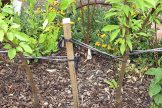
There are many beautiful plants that may be grown from bulbs, tubers, corms or roots. Many are suitable to grow in pots or small spaces and produce prolifically in the first season. They provide seasonal colour and many are excellent cut flowers.
There are three main seasons for plants grown from bulbs, corms, roots or tubers. The flowering seasons are spring, summer and autumn. Spring flowering bulbs are planted in late summer to autumn (the end of February until the end of April), summer flowering bulbs and perennials are planted in winter (the end of May until August or September), and Autumn flowering bulbs should be planted with the summer bulbs and perennials.
How to plant
Most bulbs will prefer a sunny position with well drained soil. However some will require shade. Many bulbs are drought tolerant, and are able to be left with little attention for many years.
Which way up?
For most bulbs the pointed end faces up towards the surface. However, Ranunculus is planted with
the pointed ends facing down into the soil. If you are unsure of which way to plant the bulb, plant it on the side and it will find its own way up. For roots it is important to identify the part that is the crown (this is where the buds emerge). The crown of perennials should be planted just below the surface of the soil. The planting depth of many summer flowering perennials varies according to the species, so check before planting. For spring flowering bulbs the planting depth is approximately three times the width of the bulb, but it is best to check the recommended depth before planting.
Soil
For spring flowering bulbs it is most important to plant the bulbs in soil that drains well. Some perennials will prefer well drained soil, such as Bearded Iris and Dahlias, while others will tolerate more boggy sites, Cannas and Iris ensata. For most perennials it is advantageous to improve the soil before planting by mixing in manure and compost.
Taking up bulbs
Many bulbs benefit from being dug up and stored each year before planting out again next season. If in doubt it is probably best to leave the bulbs where they are. Make sure you mark where they are to prevent damaging them when the foliage has disappeared. If your bulbs or perennials are not flowering much, then they may be too crowded. For a better display, dig up the clump, divide and plant out each division. Wait until the foliage has completely yellowed off and is starting to go brown. Carefully dig around the clump and lift the bulbs or roots together with the soil. Shake off the soil and if they are true bulbs, there will be many bulbs in the clump all separate from each other. These should have old leaves and spent bulbs removed and may be stored in a dry dark environment until the next planting season, when they must be planted out. You cannot store bulbs for several years and then plant them out. They must be planted each year. An easy way to lift and store bulbs is to plant bulbs in a basket or net, thereby allowing you to simply pull them out of the ground at the right time and store them.
For perennials the roots may be lifted and split by hand or using a sharp knife or spade. There needs to be some part of the crown with roots attached. Most perennials should be planted straight after they have been dug up, but some like Dahlias, may be stored before planting.

Planting in pots
Spring flowering bulbs are perfect to plant in pots. Use a bulb potting mix or a very sharp potting mix. The bulbs may be planted closer together in a pot than they are in the ground. Just make sure there is at least 1.5 cm between the bulbs. Fertilise with liquid fertiliser once they start to flower.
Planting ideas with bulbs and bare root perennials
The following are just some of the wide range of bulbs, tubers, corms and bare root perennials that are available.
 Important note about plant availability. Important note about plant availability.There are hundreds of factsheets on our website provided for your information. Not all plants will be available at all times throughout the year. To confirm availability please call (03) 8850 3030 and ask for the nursery. |

Variety |
Plant When? |
Flowering |
Design Use |
| Tulip | April, May | September – October | Excellent for display in pots or massed for a bold spring display in beds. |
| Scilla (Bluebells) | February – April | Mid spring | Try mass planting under trees or with daffodils through turf. |
| Ranunculus | March – May | Early spring | Plant en masse for a riot of colour in a hot sunny spot. Best to replant from fresh bulbs each year. |
| Muscari (Grape Hyacinths) | February – April | Late winter – spring | Great for pots, massed under deciduous trees or shrubs or in clumps at the front of a mixed bed. |
| Hyacinths | April – May | Spring | Perfect in pots. Plant close together for stunning displays of colour and fragrance. |
| Dutch Iris | February – April | Spring | Excellent for cut flowers. Plant in clumps or rows, just plant enough to pick and to enjoy in the garden. |
| Daffodils and Jonquils | March – April | Late winter – spring | Jonquils will flower first, followed by the Daffodils. Plant in clumps or drifts, in pots, garden beds and even in the lawn. |
| Crocus | March – April | Late winter – spring | Plant in pots or in small clumps in well drained soil in rockeries or under trees or shrubs. |
| Anemones | March – May | Late winter – early spring | Plant in clumps in mixed beds or en masse for cut flowers. |
| Iris germanica (Bearded Iris) | May – September | Early – mid summer | Plant in clumps in beds for superb colour in sunny spots. |
| Convollaria (Lily of the Valley) | July – August | October – November | Plant in a cool, semi – shaded position. Mix well rotted manure in to the soil before planting. |
| Polygonatum (Solomons Seal) | July – August | Summer | Another plant for cool shaded areas. Beautiful arched sprays of foliage with flowers suspended from the stems. |
| Dahlias | August – October | Mid – late summer & autumn | Taller varieties need staking, but there are dwarf varieties available. Excellent cut flowers, blanche the stalks. |
| Cannas | Late winter – early spring | Summer – autumn | These will tolerate a wide range of conditions. Perfect for tough spots that need some colour. |
| Liliums | July – September | November – February | Many types and colours to chose from, so plant different ones throughout the garden to prolong the display. Excellent cut flowers. |
| Delphiniums | July | January – March | Great for a taller accent at the back of a mixed planting |
| Hemerocallis (Day Lilies) | June – August | Summer – Autumn | Tough as old boots. Plant in a sunny spot in the garden for a long display. |
| Nerines | June – August | Autumn | Another hardy and long lived plant, naturalises well. |





